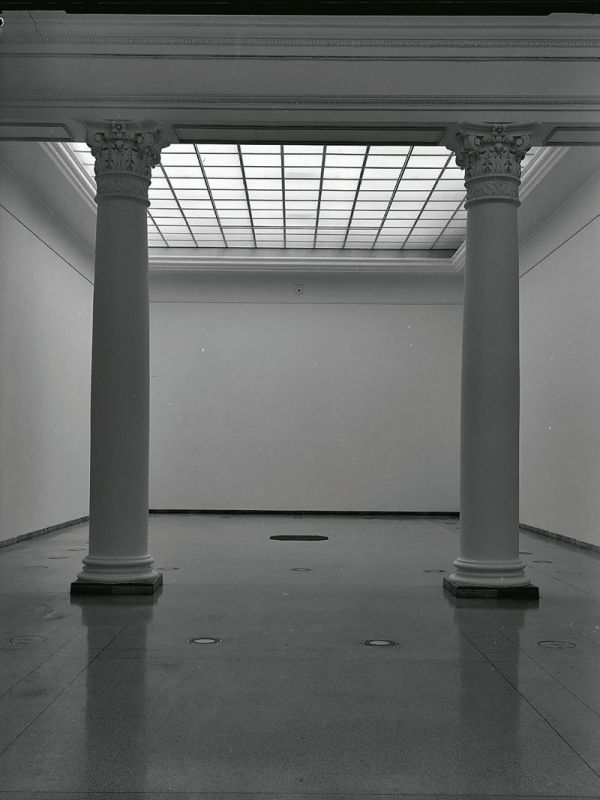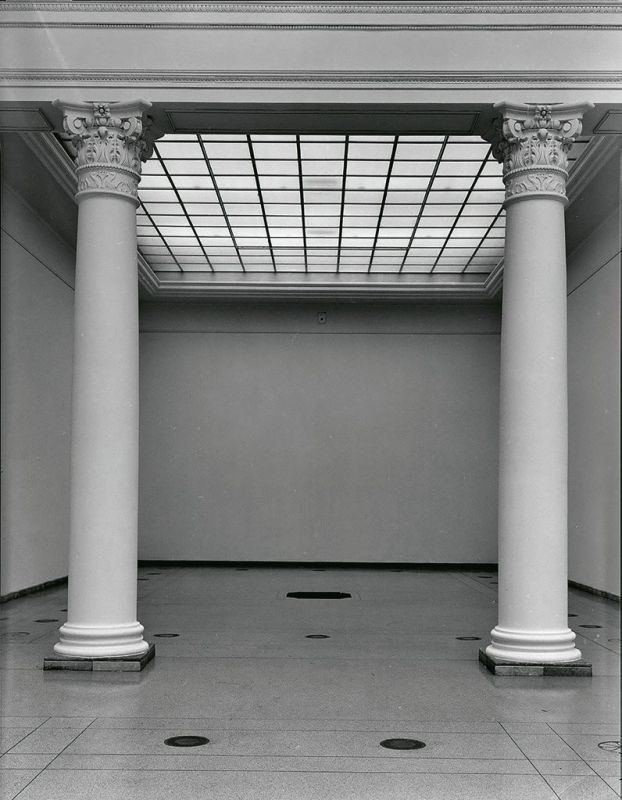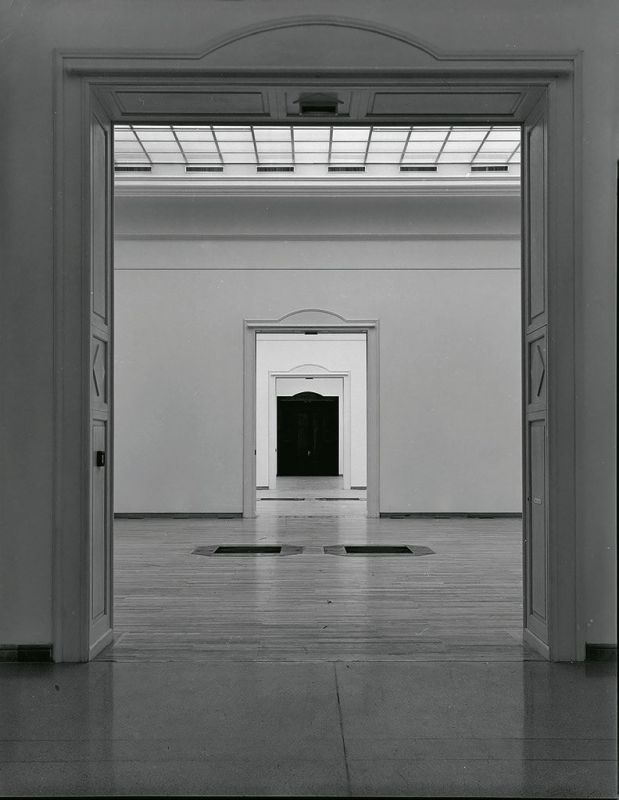“Behold the Land”. L’Oeuvre
Endre Kukorelly

Kunsthalle Budapest
_László Lugo Lugosi

Kunsthalle Budapest
_László Lugo Lugosi

Kunsthalle Budapest
_László Lugo Lugosi
“through calm essence and troublesome accident
wanders the divine farmer
leaving tidy sheaves
and picking up loose ones
the mountains and the seas
he inadvertently hurls behind
advancing through remains and deserts
his peculiar thirst quenched by the dry sand”
Sándor Weöres: Béla Bartók
Hastily, that’s how I look at pictures. “What is there to look at for so long?” I keep repeating Martin Heidegger’s line to myself. This is an even pace, not my street pace, I keep an even distance from everything. As my way of self-defence, obviously. I’m out of my depth here. I relate to these objects not like in my own home, in a purposeful, familiar way, this exhibition space is not my home. A concert hall is un-home too. You sit and make sure not to cough. Not to make a noise. Not bad, even good, but not really. Quite good. Very good. There is a café but you can’t go there now. You can’t just up and go. You wriggle, because others do too – you have to – you don’t own your own body here. You don’t wriggle in your own house, why would you, right? You stand up, you sit down, you make a noise, you don’t even know what you’re wearing, you don’t even notice what everybody notices here. You nicely close your book – because it would hurt it if you just put it next to you left open, face down. You don’t put your coffee cup on it, and if you underline anything in it, it hits you that you’re hurting it. It’s hurting you, really. You have no plan with these objects, you don’t throw them away, don’t lose them, don’t forget about them like you have with your favourite childhood toys. Being lost in the Prado is one thing but losing Schubert? I’m standing before a painting – not decently.
How then?
Not routinely, definitely not. Routine conceals things, but you don’t know what you are in for here, but there’s a chance that contemplating these things you will ask questions about their existence and yours, to quote Heidegger. It is only through the event of an artwork, through partaking in it, that the curtain of mundane reality can be torn open and the extant brought to light. Only by seeing it, but not reading into it and definitely not looking through it, will you have the chance to see something of yourself. Charles de Tolnay presumably said in connection with Paul Cézanne that only the greatest masters are worth bothering with, the rest of them do not matter. But they do! Because there are only a few of the greatest – they are always great even if they doze off at times like Homer did, or like Tolstoy, who forgot how many children Oblonksky had – but there are many who occasionally become the greatest “in the space between animals and angels”, just like Weöres’ divine farmer.
Árpád Mezei says that “most philosophers seek to know the world by itself, stripped of its relation with man”, science seeks to gain power over the world and art “to create harmony between man and the world”. Harmonia, the daughter of Ares and Aphrodite, the wife of Cadmus. Cadmus (his great-great-grandfather Zeus, appearing in the form of a bull, and great-great-grandmother Io, assuming the form of a cow) – is one of the greatest heroes in Greek mythology. His daughter Semele’s body burnt up when she lay with her thunder-bolting great-grandfather, Zeus, who snatched their child, Dionysus by sewing him in his thigh. Eurynome bore beauty (the Charites) to Zeus; reinforcing “the rules providing the natural order of the world” (Károly Kerényi), Themis, the personification of natural law, bore him the Horae, and Mnemosyn bore him the Nine Muses. The earthly counterpart of Zeus and Hera’s nuptials was that of Cadmus and Harmonia, with the participation of the gods: “the walls of Thebes were built to the sound of the lyre and the city to Amphion’s music.” The bearers of the Necklace of Harmonia, created by Hephaistos, met a terrible end. Her daughters also met a terrible end. When Apollo appeared in Delphi with the lyre given to him by Hermes, the Muses awaited him with their song and – as Kerényi writes – nine goddesses, the Charites, the Horae, Hebe, Aphrodite and Harmonia, “were dancing in a circle, holding each other by the wrist. Artemis also joined the dancers and Ares and Hermes played with them too”. Artemis turned Harmonia’s grandson into a stag and let him be torn to pieces by his own dogs. When – later, or sooner, does it make any sense? – Agenor sent Cadmus and his other sons in search of their sister, Europa, who was carried off to Crete by Zeus, who assumed the form of a bull; during his wanderings, Cadmus found Harmonia. Not Europa, but Harmonia.
I don’t have an overall picture about contemporary Hungarian painting, not in the least, so if that’s what you are after, stop reading now. On the whole, I don’t have an overall picture about anything. When it comes to literature it is so-so, I seem to know “where to deal a blow”. Like in the age-old joke, where the bearded repairman hits the TV with a hammer and brings the picture back and when the housewife is complaining why she should pay so much for a single blow the man says: you need to know where to deal that blow. Literature is my own realm but here and now where shall I deal a blow? Shall I deal blows erratically? Not being an art historian, nor an art writer, merely interested in art and obsessed with museums and exhibitions, having opened dozens of vernissages, personally knowing far more than a hundred artists, counting some of them among my friends – one is speechless, by and large. Should he blow smoke?
Should I blow smoke?
Publish a novella?
Or an epic poem?
You are standing in the corner of the exhibition hall, having appropriated a glass of mediocre wine, the opening is over, it went well. There are many people, not looking at the pictures but collectively staring at the man who gave the opening speech; I’ve experienced this many times. Why aren’t they staring at the artist instead?
Or the shapely hostess behind the counter packed with goodies and rattling with jugs of wine?
They are watching me speak, the pictures peacefully hanging on the walls, and I’m made to feel that what I’m doing here is work. Not only my work, and definitely not the work of those whose works we are here for: the ones working are those who came here for this or that reason. I point at one of the pictures, everybody turns in that direction. They quickly turn their heads that way, how atavistic! You cannot help looking there, cannot help taking your eyes off even the most captivating thing when someone enters, steps into the space where you had felt safe up to then. Why aren’t they looking at what they came here to look at; what are they staring at me for? Why aren’t they staring at the artist standing next to me uncomfortably? An artist is transliterated as creator in Hungarian – sounds ridiculous but I decided at the start that I would once write this word down.
And again: creation (artwork transliterated from Hungarian).
There.
“Montaigne called his essays an attempt – essayer means »to try« – i.e. an attempt to say something about something,” writes Sándor András in one his essays on the Avant-garde: “but some of his essays were ready, each the result of an attempt, each a work, a ’creation’” – let it be.
As far as I know, even curators, experts, don’t necessarily know everyone in the art scene. Writers are more or less in the picture about each other; there might be a certain curtain between generations but it is see-though and passable, at least it can be lifted. There are, however, four times that many fine artists, and that’s a lot. Of course, if some of them are “there for each other” at least, that’s good.
It’s not bad – but is there a depth to it? Cézanne recognised himself in the figure of a struggling painter in Émile Zola’s novel L ’Oeuvre so he severed their friendship of quarter of a century. In 1886, Zola was 46, Cézanne 47 – they had been bosom buddies since their childhood. Poetry and fine art, like two brothers. You couldn’t see the likeness of Plato, nor that of Socrates if it weren’t for the (Roman replicas) of Greek statues. Giotto di Bondone and Dante Alighieri were not merely contemporaries but in a way each other’s reflections in the Duecento and the Trecento. According to Aby M. Warburg, the concetto of Angelo Poliziano’s Stanze per la giostra, a poem about Venus, was ‘mediated’ to Botticelli by Lorenzo de’ Medici. When Matthias Grünewald started painting his Isenheimer Altar, the School of Athens (1511) and the fresco of the Sistine Chapel (1512) had been completed; it was around this time that Luther arrived at his “sola gratia” principle – efforts made to reach salvation are to no avail – but in 1510 he had still been crawling on his knees up the steps of the Lateran basilica of Rome. And so on and so forth. Goethe thought nothing of Schubert’s Erlkönig, Malevich co-wrote his manifesto of Suprematism with Mayakovsky in 1915, Thomas Mann – albeit an admirer of Wagner – “showed affinity with” Arnold Schönberg in his Doctor Faustus, written between 1943 and 1947 and adopting some texts by Theodor Wiesengrund Adorno. Acquaintances, strong mutual influences. While there is a significant difference in age between the merely 200-year-old Hungarian national painting (theatre, music, architecture) and its brother, Hungarian literature – it shows when we take Petőfi and Soma Orlai Petrich, or János Arany and Miklós Barabás, or we know for certain that Róza Laborfalvy squeezed as much out of Jókai as was humanely possible – this difference had disappeared by the end of the 19th century: Franz Liszt and Ferenc Erkel were equally Hungarian. While Bartók ’only’ adapted Béla Balázs’s text to music, Kodály composed a piece based on the Old Men written by Sándor Weöres, 15 years old at the time and 31 years his junior; and then Weöres composed a poem about Bartók, and so on and so forth. They “tuned in to” each other. They knew each other – and they did not: Kassák would have been given a Baumgarten Award by Babits, had the political powers not vetoed it, however, this doesn’t mean that he had any idea about the battles waged between Kassák and his renegades. In any case, between the two world wars, and indeed well before the first world war, writers and painters, actors and musicians sat by the same tables in the same cafés. There were five hundred, no less, literary cafés in Budapest at the time. And much later, but much longer ago than the day before yesterday, existing in a virtual void, there was the Young Artists’ Club on Andrássy Road frequented by Gábor Bódy, Tibor Hajas and… so many more, where Szentjóby and Balaskó got together; and there was the Örley Circle in Café Astoria, where Mészöly and Ottlik (did not) get on. There are none today.
Nothing like that today. Instead, the warmth of familiarity is replaced by the coldness of the lack of it, artists don’t know each other, or only accidentally, there is no insight, no knowledge, no turning to other branches of art to find new perspectives for their own questions. There would be many places to turn to.
There is a place to look around here, even if it’s not “Colonus’ glistening soil”.
“Thou hast come [...] O stranger […] to […] Colonus’ glistening soil,” goes Hippolyte Taine’s quote from the Chorus from Sophocles’ Oedipus at Colonus. “Behold the land that nourished and forged this so early maturing, majestic people,” Taine shows us around Greece. “There is no frost, but every 20 years at most; the scorching heat of summer is tempered by the breeze from the sea,” and then he continues: “this people has a custom to sleep in the streets from mid-May to late September” and then goes on to quote Euripides: “O, thou! The offspring of Erechtheus… always walking with sweet satisfaction in the radiant aether of your skies, where the sacred Nine Muses of Pieria tend to Harmonia with golden locks”, etc. Here, it’s not the same.
Is it not? Here is this land, here is this people – “majestic” or not, radiant or not, icy or not. Do people sleep in the streets? Pictures at an exhibition; panorama, a tour, the only thing connecting them is how they differ from one another, all different, they together tell us what we ask of them. “A work of art talks about the things of the world by dispelling talk about the world,” Miklós Erdély says in his Marly Theses at a meeting of the Hungarian Atelier near Paris in 1980. A commendable effort to pay attention.